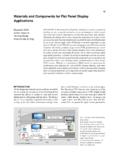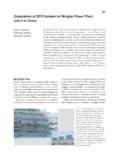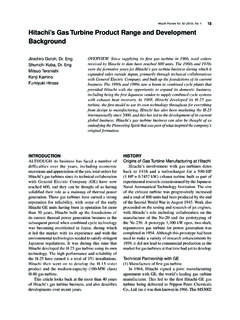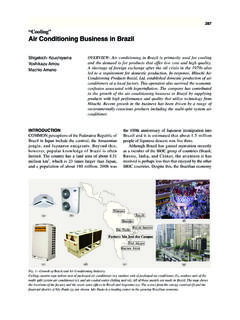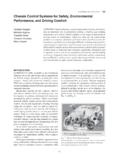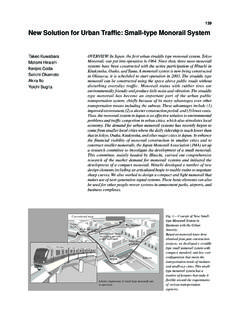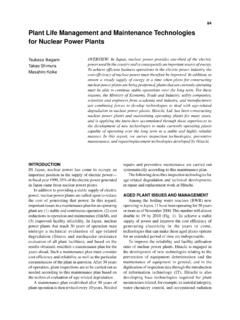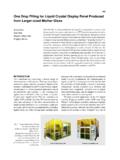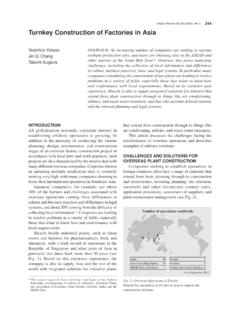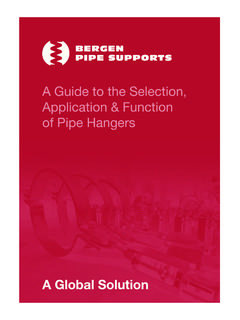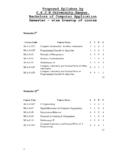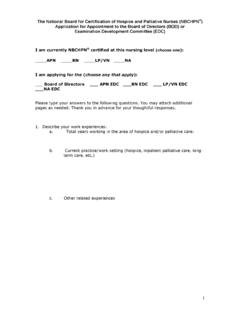Transcription of Application of Power Electronics Technology to …
1 Hitachi Review Vol. 59 (2010), No. 4 141 Application of Power Electronics Technology to Energy Efficiency and CO2 ReductionMasashi ToyotaZhi Long LiangYoshitoshi AkitaHiroaki MiyataShuji KatoToshiki KurosuINTRODuCTIONPOWER Electronics is a Technology for using Power devices to convert efficiently electric Power into the optimum characteristics. As a key component for improving the energy efficiency and performance of va r ious equipment, Power elect ron ics cont r ibutes to t he realization of both a prosperous and comfortable way of life and a sustainable society by reducing CO2 (carbon dioxide) emissions in areas as diverse as electric Power , industry, transportation, and home supplies safe, reliable, and pleasant systems by combining Power Electronics and system control OVERVIEW.
2 The effective use of electrical energy is a key technique for achieving energy efficiency, and Power Electronics technologies that can convert electric Power into the optimum characteristics for each applications are essential part of this approach. Power Electronics systems have attracted attention as key components for building a sustainable society by reducing CO2 emissions and include the use of inverters as adjustable-speed drives for motors and PCSs that provide stable connections to the Power grid for unstable DC or AC electric Power generated from solar energy, wind energy, etc. Hitachi provides systems, products, and services that contribute to reducing CO2 emissions in Power generation, industry, and other sectors in social infrastructure by combining Power Electronics with system control technologies and technologies for Power devices which are the key components in these and gas pipelineFactorySolar Power plantsRecharging standBuildingTransmissionPort (stop idling)ShipConstruction machineryRailwayPower stationSubstationASDRECR egenerative INVFCRPCSVCE lectric driveASDFCASDSVCHVDCFCBTBGrid stabilizationRapid chargerASD(air conditioning, elevators)UPSN uclear Power : ASD, EXThermal Power : EXHydro Power .
3 Starter, CYCSVCS torage battery PCSPCSASDWind farmPower gridPower gridPCSFig. 1 Contribution of Power Electronics to CO2 (carbon dioxide) Reduction in Power Generation and Electronics has a major role to play in energy efficiency, stabilizing the connection of renewable energy to the grid, and enhancing the performance and functions of : adjustable-speed drive FC: frequency changer RPC: railway static Power conditioner SVC: static var (volt-ampere reactive Power ) compensator REC: rectifier INV: inverter HVDC: high voltage direct current BTB: back to back (asynchronous link between grids) PCS: Power conditioning system EX: exciter CYC: cycloconverter UPS: uninterruptible Power systemApplication of Power Electronics Technology to Energy efficiency and CO2 Reduction 142 technologies in its social innovation businesses which extend across Power generation and general industry (see Fig.)
4 1).This article describes examples where Power Electronics and Power devices have been used in renewable energy and industrial applications , and the technological prospects of the Application for reduction of CO2 REDuCTION IN RENEWABLE ENERGY SECTORR enewable energy is treated as a last resort of CO2 reduction and the approach by its Application at the government level is being executed. The newly installed capacity by the global market in 2008 reached 28 GW of wind Power generation and GW of solar Power generation and the double-digit growth rate of the generations is expected to continue. This has drawn attention because this rapid increase in installed capacity ca n cause t he problems for t he qua l it y of t he Power g r id.
5 The following sections describe what Hitachi is doing about the Power quality problems associated with this large-scale installation of renewable for Wind PowerWind Power generation has already become a commercially viable business and the installation of wind farms is accelerating in the US, China, and Europe in particular. In China, approximately 14 GW of new capacity was installed in 2009. Hitachi is pursuing its PCS ( Power conditioning system) business primarily in released a full converter type PCS for 100-kW-class PMGs (permanent-magnet generators) on the market in 2001. The to PCSs for doubly-fed induction generators that are the mainstay of Hitachi s current business commenced production in 2006.
6 A distinctive feature of these models is that their functions include an LVRT (low-voltage ride through) function for continuous operation during instantaneous voltage drops which complies with the grid codes of various countries (see Fig. 2). Meanwhile, Hitachi is also working on the ongoing development of PCSs with high availability that can cope with the anticipated future increase in the size of wind Power for Solar PowerIn the field of solar Power , large-scale solar Power generation projects (known as mega-solar ) are planned in various countries. For these mega-solar Fig. 3 PCS for large-capacity PCS (400 kW, 420 V, 3 phase) for large solar Power generation systems ( mega-solar ).
7 Fig. 2 Features of Converter Control System for Doubly-fed Induction Generators Used for Wind system incorporates an LVRT function that complies with the grid code in various countries, torsional vibration suppression, and active- Power -based suppression analysis of wind turbine systemActive power012 Time (s)012 Time (s)Torsional vibration suppressionActive powerSuppression of mechanical vibration by current control system with fast responsePower gridPCSI nduction generatorActive- Power -based control (control to minimize fluctuation in wind Power )LVRT function(Simplification: Short-circuit circuit not required)(Shockless design: Converter ride through)Torsional vibration suppression(suppression ofvibration by controlof electric Power )GearGENG eneration of activepower fluctuations causedby mechanical resonance40 TimeActive Power (kW)Sudden change in wind speedWind speed (m/s)Constant powerSpeed downRotor speed (min1)Stator current (Arms)2502001501005003 min3020100 Wind speedActive Power , rotor speedConverter controllerLVRT: low-voltage ride through GEN: generator rms: roat-mean-squareHitachi Review Vol.
8 59 (2010), No. 4 143 projects, Hitachi supplies a 500-kW-class PCS with an LVRT function and a voltage fluctuation control function that is achieved by optimized reactive- Power control. This PCS uses a transformer-less configuration with a maximum efficiency of more than 97% (see Fig. 3).Measures for Dealing with Expansion in Installation of Large-scale Renewable EnergyAlthough renewable energy sources such as wind and solar energy contribute to reduction of CO2 emissions, the large-scale installation of such systems requires measures to maintain Power quality because unstable energy sources will be connected to the Power is working on this problem in a wide range of fields including Power Electronics and system control technologies as well as components such as storage batteries (see Table 1).
9 In the field of wind and solar energy in particular, in addition to the above-mentioned function implemented in the PCS for reducing voltage fluctuations, Hitachi is undertaking research for stabilization and maximization of the output of an entire Power plant through the cooperative control of distributed Power generations as systems for wind farm, t he f ut u re, H it ach i wil l develop t hese technologies into a smart grid that can improve the stability of the electric Power system through the interlinked control of each wind farm, mega-solar system, or other generation site from an energy management IMPROVEMENT TECHNOLOGIES FOR DRIVES AND uPSDrive Systems for General IndustryAs a means of reducing CO2 emissions to prevent global warming, the need to improve energy efficiency by using adjustable-speed drive to operate equipment such as fans and pumps at the optimum speed has strengthened in recent years.
10 To meet this demand, Hitachi launches the multi-level IGBT inverter series of medium-voltage multi-level IGBT (insulated gate bipolar transistor) drives that can drive electric motors with rated voltages in the 3-kV and 6-kV classes directly without step-up transformers. Fig. 4 shows the product rated up to 8 MVA are available for inverters with a 6-kV output voltage and Hitachi has developed a water-cooled five-level inverter to meet the demand for even larger capacities. Fig. 5 shows a picture of the inver ter a nd its block d iag ra m. T h is model con nects two three-level inverters in series and uses a control method that can output five voltage levels. The configuration consists of two 30-MVA converter banks with a output voltage and maximum output capacity of 60 M VA.
